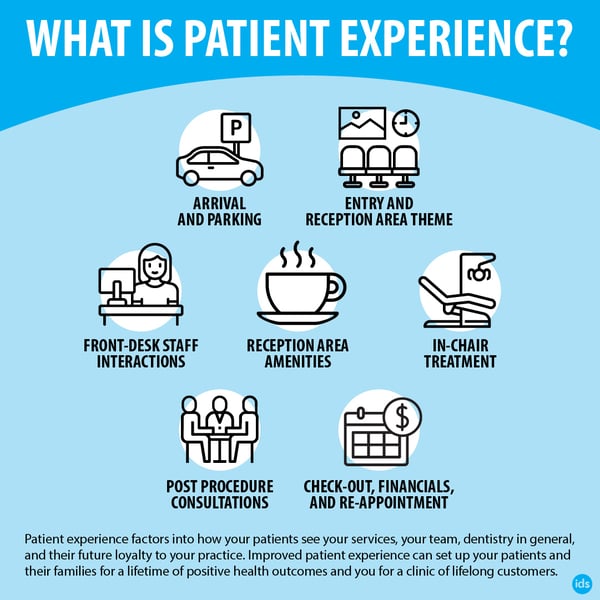Dental Patient Retention: 15 Strategies to Increase Your Retention Rate

*This post was originally published April 6th, 2017, and extensively updated August 16, 2025.
Are you struggling with your dental patient retention? As dentists, it can be disheartening to see patients leave and go to a competitor. Attracting new patients is far more costly than retaining existing ones, so focusing on patient retention is essential for practice growth.
At Titan Web Agency, while we focus on helping dentists increase their online presence, there's no point in increasing it if you can't retain the patients you have. In this guide, you'll learn what patient retention means, why it matters, and 15 strategies you can use to improve your dental patient retention rate.
What Dental Patient Retention Is and Why It Matters
As you likely know, dental patient retention refers to how well your practice keeps patients coming back for future visits. It’s a way to measure how many of your patients stay with you over time, instead of switching to another dentist or dropping out of care completely.
A high retention rate means patients trust your practice, value your care, and feel comfortable returning. This is good for both patient health and practice stability.
Retention also affects your bottom line. It costs far less to keep an existing patient than it does to attract a new one. More retained patients mean more consistent appointments, more referrals, and higher lifetime value.
The Cost of Patient Retention vs. Patient Acquisition
One reason patient retention matters is that it is far less expensive to retain an existing patient than it is to attract a new one. According to Forbes, it may cost up to five times as much to acquire a new patient as it does to hold on to a patient who has already come to your practice.
New patient acquisition requires more resources. You need to reach people unfamiliar with you and your practice, build trust, and compete with other local dentists for their attention. That means higher spending to acquire new patients.
Retention, on the other hand, builds on an existing relationship. You know who your patients are, and they (presumably) already trust your care. Nurturing that relationship through small, consistent actions such as follow-up messages, friendly reminders, or flexible scheduling costs much less.
Retention also increases lifetime value (LTV). A loyal patient who returns for routine cleanings, exams, and treatments will generate far more revenue over time than a one-time visitor. Retained patients are also more likely to refer friends and family, further reducing your marketing spend per acquisition.
Focusing on retention improves your return on investment (ROI) across the board. You spend less, earn more over time, and build a stable patient base that supports long-term growth.
Patient Retention Statistics
Now, let’s review some important patient retention statistics to help you understand why we believe that patient retention should be a priority for every dental and medical practice.
- With an average attrition rate of 17%, a practice with 1500 patients, losing 17%, means 255 lost per year, or 20+ per month.
- According to Outbound Engine, improving retention by as little as 5% can increase profits by 25% to 95%.
- Losing patients can costs dentists substantially, upwards of $33k per year in profits.
Every time a patient doesn't book their follow-up appointment when they leave, they are at a higher risk of not returning.
I'm reminded of the lucky bucket theory when I think of dentists who focus only on new patients, not on retention.

Image compliments of Customer Lifetime Value.
Why Patient Retention Is Crucial for Sustainable Dental Practice Growth
I think you'll agree with me when I say: "Patient retention is one of the most important factors in building a stable and profitable dental practice."
When patients return, your schedule stays full, your staff stays busy, and your practice becomes more profitable.
Here’s why improving your dental retention rate is essential:
- Revenue Stability: Returning patients mean consistent income. High retention supports a predictable cash flow and reduces dependence on costly acquisition campaigns.
- Reduced Marketing Costs: It’s significantly cheaper to keep existing patients than to attract new ones. A strong patient recall system helps reduce churn and keep marketing expenses in check.
- Operational Efficiency: Loyal patients keep schedules full, helping to reduce no-shows and gaps in productivity. This allows your team to operate efficiently.
- Practice Reputation: Satisfied, long-term patients are more likely to leave positive reviews and refer others. A loyal patient base boosts your credibility in a competitive market.
- Higher Lifetime Value (LTV): Existing patients who return for routine cleanings, treatments, and elective procedures provide more long-term value than one-time visits from new patients.
- Better Patient Relationships: Ongoing care builds trust. When patients feel known and cared for, they are more likely to stay engaged with their treatment and return regularly.
- Stronger Patient Engagement: Patients who stay with your practice are more receptive to follow-up care, preventive services, and other patient engagement strategies.
- Fewer New Patient Referrals: If you aren't retaining your patients, then they aren't going to go around and refer new ones to you.
- Patient Loss Affects Dentist’s Reputation: Empty chairs don’t just reduce profits; they may also send the wrong message. New patients often check online reviews and evaluate a dentist’s reputation before making an appointment. High attrition leads to fewer positive reviews and weakens patient trust.
Focusing on retention isn’t just about keeping your chairs full; it’s a foundation for sustainable growth and long-term success.
.png?width=4800&height=1728&name=Why%20Patient%20Retention%20Is%20Critical%20for%20Your%20Dental%20Practice%20(1).png)
Patient Retention Strategies to Build Loyalty and Increase Profits
As promised, here are 15 proven patient retention ideas or strategies to help you reduce patient attrition and increase your profits.
1. Make a Great First Impression
First impressions often happen before a patient ever walks through your door. Whether someone is calling to book an appointment or browsing your website, they’re forming quick judgments about your professionalism, warmth, and trustworthiness.
These first few moments can determine whether a potential patient follows through or looks elsewhere.
Why It Matters
New patients make snap decisions. Research shows people take just 8 seconds to decide if they trust a dentist’s website enough to call. If that first impression falls flat, you risk losing them entirely.
Poor phone handling or a clunky website can lead to no-show appointments, lower patient loyalty, and a higher drop-off rate after the first visit. Getting this part right supports your patient recall system and helps boost your overall dental retention rate.
Actionable Tips
- Train staff for phone excellence: Ensure all calls are answered promptly and warmly. Smiling while speaking can actually be heard, and it makes a difference. Avoid voicemail during business hours, and use a live answering service if needed.
- Script the first call: Prepare a quick-reference sheet with insurance details, doctor bios, and FAQs. Teach front desk staff to briefly introduce the dentist and explain the practice’s strengths.
- Optimize your website: Ensure it looks clean, loads quickly, and is easy to navigate. Your site should immediately communicate trust, include a clear call to action, and work seamlessly on mobile.
2. Improve the Patient In-Office Experience
The patient experience doesn’t begin in the chair. It begins the moment they walk in the door. Every interaction —from the front desk to checkout —plays a critical role in how patients perceive your practice. If they feel welcome, respected, and comfortable, they are much more likely to return and to recommend your office to others.

Photo Credit: Ids Kids
Why It Matters
The in-office experience directly impacts patient loyalty and satisfaction. Even if your clinical work is outstanding, a poor front-desk interaction or cold atmosphere can undo your efforts. In contrast, a warm, personalized experience encourages repeat visits and improves your dental retention rate.
Actionable Tips
- Create a welcoming routine: Greet patients by name, smile, and make eye contact. These personal touches help build trust and foster long-term loyalty.
- Set expectations clearly: Let patients know the estimated wait time and show them where to find restrooms, beverages, or reading materials. Small gestures help reduce anxiety and improve comfort.
- Train your front desk team: A friendly tone, calm demeanor, and proactive communication are essential. Consider training sessions or role-plays to strengthen patient engagement strategies.
- Ask for feedback: Offer a brief in-office or digital survey to understand how patients feel about their visit. Use their responses to refine your process and improve the experience.
3. Spruce Up Your Waiting Area
While it’s important to minimize the time patients wait to be seen, you still want the time they spend in your waiting area to be enjoyable. This means you’ll need to give some thought to design and decoration, as well as which amenities to provide.
Why It Matters
Your waiting area is often your patient's first in-person impression of your practice. A clean, comfortable, and thoughtfully designed space shows that you care about their comfort and experience.
These small details influence a patient's likelihood of returning, making them a key part of any patient retention strategy. A well-designed space also reinforces your brand identity and the professionalism reflected on your website.
Actionable Tips
- Prioritize comfort and warmth: Create a welcoming atmosphere with cozy seating, warm lighting, calming colors, and a few plants. Personal touches like artwork or family photos can help the space feel more inviting, especially in a family-oriented practice.
- Align design with your brand: Use a color scheme that reflects your branding across your office, website, and printed materials to maintain consistency and professionalism.
- Add thoughtful amenities: Stock your waiting area with a variety of magazines, informational brochures, and children's books if you treat young patients. Consider offering water or a small coffee-and-tea station.
- Support digital convenience: If you have a patient portal, place a few tablets in the waiting area for quick check-in or digital form completion. This modern touch adds convenience and reduces front-desk delays.
- Keep media neutral and quiet: If you choose to provide a television, keep the sound off and subtitles on, and select a calming channel such as HGTV or travel programming. This helps create a peaceful environment for everyone.
Patients of all ages will appreciate that you have taken the time and effort to create a welcoming environment. They’ll be more likely to return to your practice the next time they need to see a doctor or dentist.
4. Stay on Schedule
When your patients experience long wait times, it sends a message of indifference. Keeping your appointments on time shows patients that their time is respected, which strengthens trust and satisfaction.
Why It Matters
Long wait times do more than cause frustration; they directly impact how patients view your practice. Research shows that factors such as waiting time, physical facilities, and staff communication strongly predict patient satisfaction in dental care settings.
When patients sit too long in the waiting room, it can hurt their overall impression of your care and your practice’s reputation. On the other hand, a well-managed schedule helps support higher dental retention and improved patient loyalty.
Actionable Tips
- Book wisely: Train your front desk staff to allow enough time for each procedure and avoid overbooking. Be realistic about how long common treatments take so patients don’t feel rushed or neglected.
- Use smart scheduling tools: Automated systems can send reminders that allow patients to confirm or reschedule as needed. This is one of the most effective ways to reduce no-shows and cancellations.
- Hold daily schedule reviews: Encourage your team to assess the schedule every morning to anticipate walk-ins, emergencies, or cancellations. This keeps the day running smoothly and helps fill gaps with existing patients who might want same-day treatment.
- Monitor and adjust: Track trends in appointment delays or frequent late arrivals. Over time, this data can help you refine your patient engagement strategies and set more accurate time blocks for visits.
5. Guide the Patient Through the Visit
A patient’s impression of your practice is shaped by more than just the treatment they receive. From check-in to check-out, every interaction matters. Creating a structured and thoughtful experience helps patients feel more comfortable and confident in your care.
Why It Matters
Many patients experience anxiety during dental visits, often due to a lack of control or uncertainty about what’s coming next. When your team takes the time to explain each step of the process, it not only eases anxiety but also builds trust. This level of communication enhances patient satisfaction, strengthens patient-dentist relationships, and supports long-term dental retention.
Actionable Tips
- Greet and escort with intention: Train team members to greet patients warmly and escort them to the exam room while engaging in friendly conversation. Small gestures
- Listen and respond: If a patient shares a concern or discomfort, address it sincerely and promptly. Feeling heard makes patients more likely to return and refer others, increasing your patient loyalty and engagement over time. Like using the patient’s name or asking a casual question can go a long way.
- Provide a clear roadmap: Let patients know what to expect before any part of their visit begins. A simple explanation, such as “Next, Anna will take your digital x-rays, then Sarah will perform your cleaning,” helps patients feel more in control and reduces dental anxiety.
- Introduce team members: If a patient hasn’t met a staff member before, a quick introduction makes the interaction more personal. It also avoids confusion and reinforces a seamless, professional environment.
- Be mindful of comfort: Check in during the visit to ask how the patient is feeling. Some patients won’t speak up unless prompted, so showing attentiveness builds a sense of safety and care.
6. Get to Know Your Patients and Don’t Rush
While it takes a team to deliver great care, many patients place the most value on their one-on-one time with their dentist. That moment is often the make-or-break point for whether a patient leaves satisfied. Taking time to build a real connection goes a long way in improving the patient experience.
Why It Matters
Patients are more likely to trust and return to a dentist who treats them as individuals, not just names on a schedule. When you show genuine interest in their lives and give them the time and attention they deserve, it builds loyalty and strengthens relationships.
Rushing through appointments, on the other hand, can make patients feel like they’re just another task to complete. Slowing down and staying present enhances the overall patient experience and keeps patients coming back.
Actionable Tips
- Make a warm first impression: Introduce yourself with a smile and a handshake. Let new patients know you appreciate them choosing your practice, and ask how their experience has been so far.
- Ask meaningful questions: Get to know your patients by asking about their work, family, or background. Even small talk can help patients feel seen and valued.
- Remember the details: Encourage your team to leave personal notes in patient files, including hobbies, family names, and major life events. Referencing these details during follow-up visits shows you care.
- Address every concern: Be thorough when reviewing treatments. Explain what the procedure involves, how long it will take, what it will cost, and what financing options are available. Use visuals to support your explanations when needed.
- Don’t rush the checkout: The final interaction of the visit matters too. Walk patients through the next steps and make sure they leave with a written copy of their treatment plan or, if applicable, a cost breakdown. Offer a private area for discussing financial questions.
- Extend the relationship beyond the chair: Consider writing a blog that shares your knowledge, tips, and personal insights. It helps patients feel connected to your practice and gives them more reasons to trust you as their long-term dentist.
7. Make Appointment Scheduling and Billing a Breeze
When it’s difficult or frustrating for patients to book an appointment or pay their bill, they’re more likely to find a dental practice that makes the process easier. Convenience goes a long way in improving patient satisfaction and encouraging long-term loyalty. Bottom line, you will improve on your goal of retaining patients if you make it easy to do business with you.
Why It Matters
Today’s patients expect flexibility and efficiency. Complicated scheduling systems and outdated billing methods can hurt your dental retention rate and create unnecessary barriers to care. A seamless experience helps improve patient engagement and supports both new and existing patients throughout their care journey.
Actionable Tips
- Use a patient portal: Online portals allow patients to schedule, reschedule, or cancel appointments, verify insurance, and pay bills anytime. If your current system doesn’t offer these features, consider upgrading to practice management software that includes a modern patient portal.
- Promote the benefits: Help patients understand the value of using your portal. Share instructions during checkout, send follow-up emails, or create a quick how-to video to walk them through the process.
- Support patients who prefer to call: Not all patients are comfortable using digital tools. Train your team to answer calls promptly and provide a friendly, efficient experience for those scheduling over the phone or asking about a balance.
- Keep billing clear and simple: Make invoices easy to read and offer multiple payment options, such as online, in person, or over the phone. This makes the process more manageable for patients and helps reduce payment delays.
8. Schedule the Next Appointment Before They Leave
The best time to get patients to commit to their next visit is while they’re still in the office. Whether it’s a routine cleaning or the next step in a treatment plan, booking before they leave helps reinforce the importance of ongoing care and reduces the risk of patients falling off the radar.
Why It Matters
Missed cleanings and skipped follow-ups directly affect your dental retention rate. If patients don’t book their next visit before they walk out the door, there’s a good chance they’ll forget, delay, or never reschedule. Making it standard practice to schedule at checkout helps improve continuity of care and strengthens patient loyalty.
Actionable Tips
- Make it standard practice: Train front desk staff to always check whether a follow-up or hygiene appointment is needed and schedule it before the patient leaves. This should be part of the default checkout process.
- Use clear, confident language: Phrases such as “Let’s go ahead and schedule your next cleaning now so we get you a time that works best” gently guide patients without making it feel optional.
- Emphasize the benefit to the patient: Explain how pre-booking helps them stay on track and ensures better long-term oral health.
9. Use Marketing Strategies That Target Your Patients’ Interests
Marketing isn’t just about visibility. It’s about showing patients that you understand what matters to them and that you’re the right dentist to meet their needs.
Why it matters
Effective dental marketing builds trust and strengthens patient engagement. It also improves your dental retention rate by helping existing patients stay connected to your practice. But since dentistry falls under healthcare, you must also be mindful of HIPAA compliance. Any time you share patient-related content — such as reviews, images, or testimonials —privacy protection is non-negotiable.
Actionable Tips
- Share content that resonates with your patients: Use your blog and social media to highlight topics such as teeth whitening, dental implants, or preventive care tips. This shows your expertise and keeps patients informed.
- Use social media to stay connected: Show behind-the-scenes glimpses of your team and office, answer common dental questions, and post reminders for seasonal treatments or promotions.
- Highlight your focus areas: If you specialize in cosmetic, restorative, or family dentistry, make sure your dental marketing consistently reinforces those strengths so patients remember what makes you different.
- Personalize your messaging: Create content that speaks to both new and existing patients. New patients may respond to special offers or educational content, while existing ones benefit from treatment reminders or loyalty incentives.
10. Motivate Patients with a Loyalty Or Membership Program
Loyalty and membership programs are a great way to encourage long-term patient relationships. They show patients that you value their commitment and give them something extra to look forward to at each visit.
Why it matters
Strong dental retention often comes down to patient loyalty. When people feel they’re getting consistent value from your practice, they’re less likely to leave for a competitor. A well-designed loyalty or membership program can make your practice the obvious choice.
Actionable Tips
- Reward consistent visits. Create a simple loyalty program that rewards patients for showing up. You might enter them into a drawing each time they come in or offer small perks for biannual visits.
- Offer a dental membership program. These are perfect for preventive care practices. Patients pay a monthly or annual fee and receive a bundle of services, typically at a discounted rate. A basic package might include: Two cleanings per year, Two dental exams per year, Bitewing X-rays
-
Use technology to your advantage. Tools such as dental imaging software make diagnostics quicker and more accurate, thereby improving the overall patient experience. When patients see you're using modern tech, it reinforces trust and long-term value.
These programs work because they make patients feel like they’re part of something. And when patients are financially and emotionally invested in your practice, they’re much more likely to stay loyal.
11. Capitalize on Social Proof
Social proof can go a long way toward improving patient retention for any dental practice. Patients want to feel good about the dentist they choose. That means showing them you’re trusted by others, confident in your care, and committed to their experience.
Why it matters
Social proof builds trust, boosts credibility, and reassures patients that they’re making the right choice. When patients see real feedback, reviews, or recognition, it strengthens their emotional connection to your practice. It also supports your dental retention rate by reinforcing that they’re in capable hands. Just remember to get proper consent for anything patient-related and always follow HIPAA regulations.
Actionable Tips
- Share patient testimonials: Add them to your website or social media to highlight real experiences and outcomes.
- Display your credentials: Show awards, certifications, or media mentions that validate your expertise.
- Encourage online reviews: Ask satisfied patients to leave honest feedback on platforms such as Google or Healthgrades.
- Launch a dental referral program: Give existing patients an incentive to refer others. A free whitening treatment or account credit can be both simple and effective.
- Protect patient privacy: Get written consent before sharing any patient stories or photos, and avoid revealing any details that could indirectly identify someone.

Here's an example of social proof from Kirkland Family Dentistry
12. Solicit Patient Feedback and Act on It
Patients want to feel heard, and one of the simplest ways to show them you care is by asking for their feedback. Whether it’s about their experience in your office or the care they received, giving patients a voice builds trust and helps you improve over time.
Why it matters
Feedback is one of the most valuable tools you have for improving patient satisfaction and loyalty. It shows patients that you’re open to growth and committed to providing excellent care. Taking action on what they share helps prevent small frustrations from turning into lost relationships.
Actionable Tips
- Send post-visit surveys: Email a short, anonymous survey after each appointment to gather feedback. Keep it brief so patients are more likely to complete it.
- Encourage public reviews: In your follow-up messages, invite patients to share their experience online. A simple prompt asking patients to review your practice on Google can go a long way in building credibility and improving local visibility.
- Monitor feedback trends: Use survey results and reviews to spot recurring issues. If patients mention the same concern, take it seriously and look for ways to improve.
- Respond to reviews promptly: Aim to reply to every review within 24 to 48 hours. This shows patients that their opinions matter and helps you maintain a strong reputation.
- Handle negative feedback with care: Respond calmly and respectfully. If necessary, move the conversation offline to resolve the issue while maintaining privacy and professionalism.

13. Engage in Social Responsibility
Today’s patients, particularly young people, prefer to do business with companies and dentists who engage in social responsibility. Simply stated, it can help you retain patients if you take an interest in the community and world beyond your practice.
Why it matters
Patients are more likely to stay loyal to a dental practice that demonstrates care for the broader community. When your values align with those of your patients, it builds a deeper sense of connection and trust.
Actionable Tips
- Support causes that reflect your values: Partner with local organizations or nonprofits that align with your mission. You might host a fundraiser or donate a percentage of profits to a dental-related cause such as Smile Train.
- Offer pro bono care when possible: Consider donating services to underserved populations, such as foster youth or low-income families.
- Share your efforts publicly: Highlight your initiatives on your website and social media. Patients appreciate knowing the ways their dentist gives back.
- Use in-office materials to spread awareness: Include brochures or posters in your waiting room to show your ongoing commitment to social impact.
- Get the team involved: Encourage your staff to participate in volunteer days or community events to reinforce your practice’s shared values.
14. Get Your Team on Board
A dental practice is only as strong as the team behind it. While the dentist’s name might be on the door, every staff member contributes to the patient experience and plays a role in retention, from the front desk to the hygiene chair.
Why it matters
Patients are more likely to stay with a practice when every interaction feels smooth, respectful, and consistent. A well-trained and engaged team helps build that trust by ensuring patients feel valued at every visit. This not only improves the overall patient experience but also supports long-term loyalty and a stronger dental retention rate.
Actionable Tips
- Create a clear retention policy: Outline expectations for phone etiquette, appointment scheduling, referrals, and handling feedback or complaints.
- Train all new hires: Incorporate patient retention strategies into onboarding so every staff member understands their role in supporting the practice’s goals.
- Check in with patients: Ask how they were treated during their visit and take any concerns seriously. Use the insights to guide team coaching.
- Encourage internal feedback: Your team is on the front lines. Invite their input about recurring issues or suggestions to improve patient satisfaction.
- Recognize standout efforts: Highlight and reward employees who consistently contribute to a positive patient experience.
15. Automate Appointment Reminders and Follow-Ups
Consistent communication is one of the easiest ways to reduce no-shows and keep patients coming back. When patients receive timely reminders, they are less likely to forget appointments or delay follow-up care.
Why it matters
Missed appointments can disrupt your schedule and lead to gaps in patient care. By automating reminders, you help patients stay on track while freeing your team from manual calls or emails. This small change can make a big impact on your dental retention rate and office efficiency.
Actionable Tips
- Set up automated text and email reminders: Choose a dental software that lets you schedule reminders several days in advance, with a final message the day before.
Include details patients need: Make sure reminders include the date, time, dentist’s name, and any prep instructions. - Automate post-visit follow-ups: Send a friendly message thanking patients for coming and reminding them to schedule their next visit.
- Make it easy to reschedule: Include a link or phone number so patients can quickly change appointments if needed.
- Track response patterns: Review open and confirmation rates to see what timing works best and adjust accordingly.
How to Calculate Your Patient Retention Rate
Before you can improve patient retention, you need to know where you stand. Measuring your current patient retention rate is the best way to evaluate the effectiveness of your strategies over time.
Start by choosing a period to measure — for example, a single quarter or a full year. Then use this simple formula:
- E = Number of existing patients at the end of the period
- N = Number of new patients during that period
- S = Number of patients at the beginning of the period
- PRR = Patient Retention Rate
Let’s break it down with an example. Suppose a dental practice wants to calculate its retention rate for the year. They began the year with 275 patients and ended with 300, 170 of whom were new. The formula would look like this:
[(300 - 170) / 275] × 100 = 47.27%
That means the practice retained just 47.27% of its patients during the year, and lost 52.73%. Clearly, there’s room to grow.
We recommend calculating your patient retention rate for the previous year and then reviewing it quarterly moving forward. This will help you track progress, spot trends, and make smarter decisions to improve long-term patient loyalty.
Patient Retention Mistakes That You Should Avoid
To start on the right foot in improving patient retention in your practice, here are common patient retention mistakes to avoid and suggestions for addressing them.
- The patient experience is lackluster: Patients expect more than a greeting and a safe place to wait for their appointments. Providing a pleasant environment and getting your staff on board with treating patients like family can go a long way toward improving patient retention.
- Not rebooking patients before they leave your office: The best time to schedule a follow-up appointment or a routine checkup is when they leave your office. You can facilitate rebooking by having the staff member who escorts a patient to the front desk remind the front desk staff that the patient requires a new appointment.
- Not following up with patients after they see you: Making a quick follow-up call to see how they’re feeling or whether the medication you prescribed is working ensures patients feel valued and know you care. In other words, it’s time to get serious about building patient relationships.
- Not maintaining an active social media presence: If your social media pages are rarely or never updated, then it’s easy for your existing patients to lose sight of what you provide. You can address this issue by sharing relevant news, blog posts, and other information that your patients are likely to find useful and informative.
- Keeping patients waiting: Scheduling is as much an art as it is a science. As a dentist, it’s your job to make sure your staff knows how much time to schedule for each patient and that you provide patients with the care they need while also respecting their time.
- Not responding to negative reviews: As we mentioned above, negative reviews represent an opportunity. One unpleasant experience can turn a patient away from your practice, but if you address that experience quickly and professionally, you can still retain your patient. Make sure to check reviews regularly and respond promptly.
- Not having a strategy to retain patients: Patient retention doesn’t improve without a strategy. You can use the 15 strategies we’ve listed here to understand why patients are leaving your practice and what you can do to keep them, then create a concrete plan for you and your staff to follow.
Avoiding these mistakes or taking steps to correct them if you have been making them can help you improve your patient retention while still growing your practice by attracting new patients.
Why Retaining Dental Patients Offers Higher ROI Than Acquisition
Growing your dental practice does not always mean bringing in new patients. In fact, retaining your current patients often delivers a much higher return on investment and at a lower cost.
Research shows that it can cost five times as much to attract a new patient as to retain an existing one. And that is not the only advantage. Increasing patient retention by just 5 percent can boost your profits by anywhere from 25 percent to 95 percent.
The reason is simple. Loyal patients are more likely to schedule regular appointments, accept recommended treatments, and refer friends or family. They also tend to require fewer resources per visit because they already know your processes and trust your team.
Retention strategies also pay off in the long run. While marketing campaigns for new patients often involve high upfront costs from ads to promotions, your investment in retention builds stronger relationships and more predictable revenue over time.
If you are looking to get more from your marketing budget, patient retention should be a top priority.
Case Study: Boosting Patient Engagement with Branding and Website Optimization
When Dr. Eric Xu took over Pacific Northwest Dental, the practice had strong values, including minimally invasive care, transparency, and patient education; however, its branding and website didn’t reflect these values. As a result, new and existing patients struggled to connect with what made the practice different.
What Changed:
-
The practice was rebranded as Precision Dentistry of Olympia to better reflect its specialized approach and location, helping with both perception and local SEO.
-
The website was completely redesigned with a modern look, clear messaging, and visible appointment buttons, making it easier for patients to understand the practice and book online.
-
Testimonials and educational content were added to build trust and highlight the conservative, patient-first approach.
-
SEO work boosted visibility in local search, making it easier for new patients to find the practice.
The Impact:
-
Monthly leads grew from under 20 to over 200.
-
Organic traffic jumped 821% year-over-year.
-
The practice ranks at the top of local Google searches for high-intent terms like “implant dentist Olympia” and “emergency dental near me.”
-
The rebrand has helped patients feel more confident, understood, and eager to return.
Below is an image showing Precision Dentistry of Olympia’s steady increase in monthly leads during 2024, reaching 1,484 total leads by year-end.

This case proves that investing in better branding and a user-friendly website doesn’t just bring in new patients; it creates a smoother, more engaging experience that keeps them coming back.
Below is an image showing Precision Dentistry of Olympia’s improved Google organic and local search rankings, with most targeted dental keywords now holding top two positions.
.png?width=2645&height=1790&name=image%20(1).png)
Frequently Asked Questions About Patient Retention
Below are some of the most common questions dental practices ask about keeping patients engaged and coming back.
How do I improve my dental patient retention rate?
Start by creating a great experience from the first interaction. Make scheduling easy, deliver excellent in-office care, follow up after appointments, and stay in touch between visits. Consistency is key, so make sure your team is aligned and your communication is clear.
What is considered a good retention rate for dentists?
A solid patient retention rate for most dental practices falls between 70 and 80 percent. However, according to this study, the average rate is 57% (over a 36-month period). If yours is lower, it might be time to reassess your patient experience, communication efforts, or rebooking process.
Why do dental patients stop coming back?
Common reasons include long wait times, lack of follow-up, poor communication, or simply forgetting to schedule their next visit. Sometimes, patients leave because they don't feel valued. These issues are often fixable with the right strategy and team awareness.
Should I offer loyalty perks or discounts?
Incentives can help, but they shouldn't replace the fundamentals. Perks such as birthday emails, referral rewards, or flexible payment options can enhance loyalty when paired with excellent care and communication.
How do I know if my strategies are working?
Track your patient retention rate regularly — quarterly or yearly — and compare it over time. Monitor other indicators too, such as reappointment rates, patient satisfaction, and online reviews. If you see steady improvement, your efforts are paying off.
What tools or platforms help automate dental patient retention?
Platforms such as NexHealth streamline patient communication, appointment reminders, and follow-ups. Many of these systems also offer AI scheduling tools that reduce no-shows and improve overall efficiency. Automating these touchpoints can free up your team while keeping patients engaged.
Ready to Take Your Dental Practice to the Next Level?
Patient retention isn’t a quick fix; it’s a long-term strategy that starts with better communication, consistent follow-ups, and a great patient experience.
At Titan Web Agency, we help dental practices like yours improve retention through smart marketing. That includes optimizing your website, managing online reviews, and creating a brand that builds trust from the first click.
Want to Keep More of Your Dental Patients Coming Back?
Book a FREE patient retention strategy call!
Learn proven ways to boost your dental retention rate and strengthen patient loyalty—starting today.
Tyson Downs is the founder of Titan Web Agency, a company specializing in marketing for dental professionals. With an impressive track record of working with over 100 dental practices, Tyson has a deep understanding of the unique marketing needs within the dental industry.











.png)
.png)


